Climbing BlogsThese climbing blogs are good sources for current route conditions on Rainier. Mount Rainier Climbing Rangers Blog 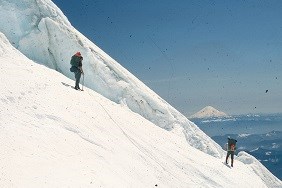
NPS photo Mountaineering reportsThe Mountaineering Reports and Statistics page has information on the highlights of the climbing season, search and rescue reports (1997-2000 and 2002) and statistics on total number of climbers and the number of successful climbers from 1852-1897 and 1950 to 2016. Names of places and features on the mountainTacoma Public Library's Washington State Names Database provides the origin of many of the names of places in the park including prominent features on the mountain. Mount Rainier National Park Names (pdf) by Gary Fuller Reese is an additional source for the origin of place names in the park. 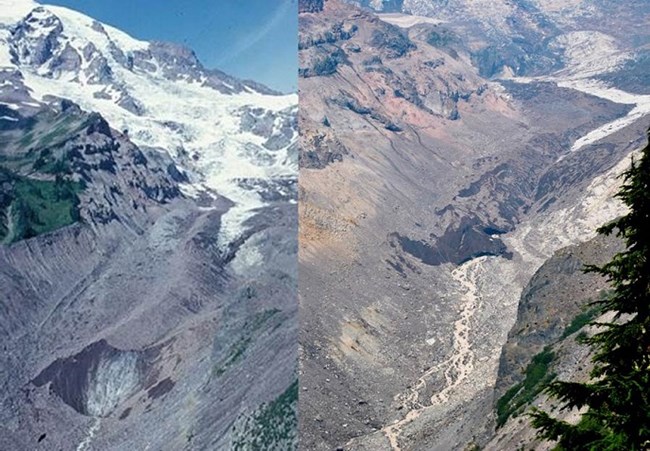
NPS/Patti Oleson Research on Mount Rainier's glaciersIn the summer of 2014, Park Geologist Scott Beason reported on the alarming rate of retreat of the Nisqually and Emmons Glaciers over the past decade. The Nisqually was retreating at the rate of 3.3 ft/10 days (1 m/10 days) while the Emmons was 3.3 ft/month (1 m/month). His report was based on aerial photographs of the glaciers. As of September 2015, preliminary surveys on the Nisqually show the glacier has receded 492 ft. (150 m) over the last 16 months. That is a rate of one foot per day (.3 m/day). The Emmons glacier's history is more erratic. From 1745 - 1900 the glacier retreated at a rate of 5.6 ft/yr (1.7 m/yr) but then it increased it's retreat to about 132 ft/yr (40.2 m/yr). In December 1963 there was a huge rockfall onto the Emmons from Little Tahoma. The rock covering insulated the glacier which caused it to start advancing. From 1964 to 1984 the glacier advanced .62 miles (1 km). Since 1984 the Emmons glacier has retreated at the rate of about 37 ft/yr (11.3 m/yr). Losing Paradise: Climate change is changing Mount Rainier - Rob Carson and Dean Koepfler provide a well written and illustrated article on the effects of climate change on the glaciers in the park published by the Tacoma News Tribune. Glacier Monitoring in the National Parks of Washington: A Virtual Field experience - One of the main attractions to Mount Rainier is its glaciers yet very few people are able to have a significant experience on a glacier. Professor Frank Granshaw from Portland State University is researching the possibility of using virtual reality technology to allow visitors to experience glaciers to enhance their understanding and appreciation of them. Climate Monitoring in Mount Rainier National Park – by Rebecca Lofgren and Barbara Samora North Coast and Cascades Network (NCCN) Glacier Monitoring Program
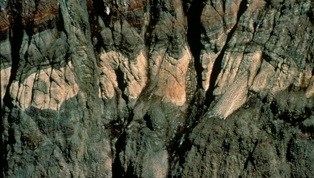
NPS/Hobbit Geology of RainierRoadside Geology of Mount Rainier National Park and Vicinity - Patrick T. Pringle, (2008). Available in spiral binding or a free download. Part I is a geologic history of Mount Rainier and its immediate surroundings. This book is written for anyone with a basic understanding of geology.
Geological features and processes on Mount Rainier 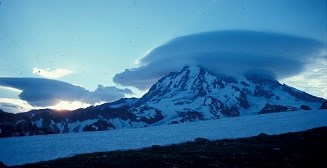
NPS photo Lenticular cloudsLenticular clouds, also known as Altocumulus Standing Lenticularis, are common on Mount Rainier. They form when fast moving, moisture laden "laminar" airflow (winds at high elevation with little or no turbulence or sheer) hit an obstruction perpendicular to the airflow. As the air hits the obstruction and flows over it, the air undulates in "sinusoidal" waves somewhat like the moving concentric ripples made on a pond when a pebble is thrown in. At the crest of the wave, the rising air reaches its dew point causing the moisture in the air to condense and form clouds. As the air falls on the downside of the wave, the clouds re-evaporate in the warming temperature. Even though air is constantly flowing through the lenticular, condensing on one end and evaporating on the other, the lens shaped cloud appears to be stationary over the mountain. Current weather conditionsA 7-day weather forecast, updated at 4:30 am and 3:30 pm daily, is specially prepared for Mount Rainier by the National Weather Service. Additional weather information is available on the weather page. 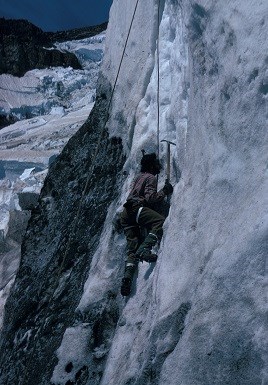
NPS Archive Photo Stories of Historic Climbs of Mount RainierThe following short bibliography covers the early history of climbing at Mount Rainier and first ascents via the various routes. The books were written by the people who did the climb or who have been intimately involved with the climbing community at Mount Rainier. Molenaar, Dee. The Challenge of Rainier: A record of the explorations and ascents, triumphs and tragedies, on the Northwest's greatest mountain. Seattle: Mountaineers, 1979. Meany, Edmond S. Editor. Mount Rainier: A record of exploration. NY: Macmillan Co., 1916. Haines, Aubrey L. Mountain Fever: Historic Conquests of Rainier. Seattle: University of Washington Press, 1999. Gauthier, Mike. Mount Rainier: A climbing guide. Seattle: Mountaineers, 2005. |
Last updated: January 28, 2025
